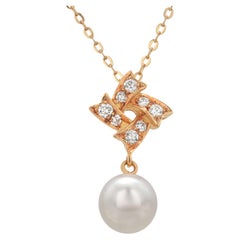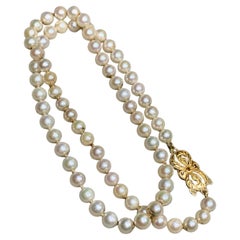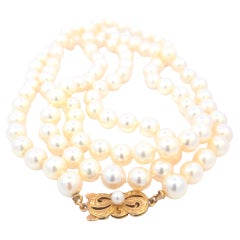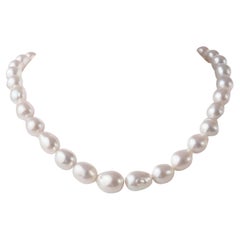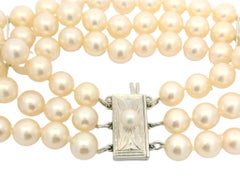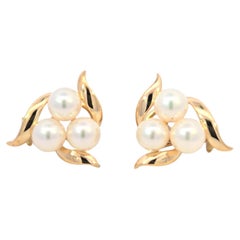Mikimoto Jewelry
Born to a noodle-shop owner, Japanese jeweler Kokichi Mikimoto (1858–1954) worked in the seafood business before shifting his focus to pearl cultivation. In 1893, he successfully developed the world’s first cultured pearls with a semispherical specimen. His further experimentation would include black and white South Sea pearls. This development gave Mikimoto a supply of what had once been a notoriously rare natural element and earned him the nickname “The Pearl King.” As he once said, “My dream is to adorn the necks of all women around the world with pearls.”
In 1899 in Tokyo’s Ginza district, Mikimoto opened his first, eponymous store in a white-stone building reminiscent of the color of pearls. He quickly earned a reputation for dazzling designs that blended Japanese craftsmanship and European influence. Mikimoto sent his jewelers to Europe to study the latest trends in jewelry and design; they brought back knowledge of Art Deco and Art Nouveau styles, which were incorporated into designs featuring Mikimoto’s pearls.
But Mikimoto’s creations were not met with enthusiasm by all. In 1921, a London newspaper called the designer’s jewelry “only imitations of real pearls” and claimed the company was “misleading” its customers. It developed into a lawsuit in the French courts, which ruled in Mikimoto’s favor, and raised the jeweler’s global profile.
He also brought his work international acclaim through exhibitions and world’s fairs, including the 1926 Sesquicentennial Exposition in Philadelphia where he unveiled a replica of the Liberty Bell covered with pearls. In 1927, Mikimoto met with Thomas Edison, who gave the jeweler’s invention probably its best compliment: “It is one of the wonders of the world that you were able to culture pearls. . . . This isn’t a cultured pearl, it’s a real pearl.”
Following World War II, Mikimoto opened stores around the world, with locations now in Paris, New York City, Los Angeles and Shanghai. Though its founder died in 1954, the Mikimoto company has continued to build on the legacy he established, producing collections of pearl necklaces and other pearl-centric jewelry that span a wide range of styles.
In 2017, the brand reopened its flagship Tokyo store, tapping architect Hiroshi Naito to design a new glittering facade whose 40,000 tiny glass plates are meant to evoke the movement of the ocean as they catch the light. The place where Mikimoto had his legendary success over a century ago is now known as Mikimoto Pearl Island and includes a museum on his life and pearls. A highlight is the “Boss’s Necklace,” which was the first made by Mikimoto and is the model for all the brand’s classic strands that have followed.
Find Mikimoto pendant necklaces, choker necklaces and a range of other jewelry on 1stDibs.
20th Century Japanese Modern Mikimoto Jewelry
Diamond, Pearl, Gold, 18k Gold, Yellow Gold
Late 20th Century Contemporary Mikimoto Jewelry
Pearl, 18k Gold, Yellow Gold
21st Century and Contemporary Mikimoto Jewelry
Pearl, Cultured Pearl, 18k Gold, Yellow Gold
20th Century Mikimoto Jewelry
Pearl, White Gold
20th Century Mikimoto Jewelry
Pearl, Gold, 14k Gold, White Gold
21st Century and Contemporary Mikimoto Jewelry
Pearl, 14k Gold, Yellow Gold
21st Century and Contemporary Mikimoto Jewelry
Pearl, 18k Gold
Mid-20th Century Mikimoto Jewelry
Pearl, Sterling Silver
1990s Japanese Mikimoto Jewelry
Pearl, 18k Gold
21st Century and Contemporary Mikimoto Jewelry
Diamond, Pearl, 18k Gold, White Gold
20th Century Mikimoto Jewelry
Pearl, 14k Gold, Yellow Gold
2010s Japanese Mikimoto Jewelry
Pearl, Silver
1990s Japanese Mikimoto Jewelry
Pearl, 18k Gold
21st Century and Contemporary Mikimoto Jewelry
Diamond, Pearl, 18k Gold, Yellow Gold
21st Century and Contemporary Mikimoto Jewelry
Diamond, Pearl, Cultured Pearl, Gold, 18k Gold, Yellow Gold
21st Century and Contemporary Japanese Modern Mikimoto Jewelry
Pearl, Cultured Pearl, 18k Gold, Yellow Gold
20th Century Mikimoto Jewelry
Pearl, 14k Gold, White Gold
21st Century and Contemporary American Modern Mikimoto Jewelry
Diamond, South Sea Pearl, Gold, 18k Gold, White Gold
1970s Japanese Modernist Vintage Mikimoto Jewelry
Diamond, Pearl, White Diamond, Gold, White Gold, 18k Gold
21st Century and Contemporary Mikimoto Jewelry
Pearl, 18k Gold, White Gold
1990s Japanese Mikimoto Jewelry
Pearl, Sterling Silver
20th Century Mikimoto Jewelry
Pearl, Sterling Silver
21st Century and Contemporary Mikimoto Jewelry
Pearl, Gold, 18k Gold, Yellow Gold
Mid-20th Century Retro Mikimoto Jewelry
Pearl, 14k Gold, Yellow Gold
21st Century and Contemporary Japanese Contemporary Mikimoto Jewelry
Pearl, Cultured Pearl, 18k Gold, White Gold
2010s Japanese Modern Mikimoto Jewelry
Cultured Pearl, 18k Gold
1990s Modern Mikimoto Jewelry
Pearl, Coral, Platinum, Yellow Gold, 18k Gold, 14k Gold, Gold
1990s Modern Mikimoto Jewelry
Diamond, Gold, 18k Gold, Yellow Gold
1990s Japanese Mikimoto Jewelry
Pearl, Sterling Silver
21st Century and Contemporary Japanese Contemporary Mikimoto Jewelry
Pearl, 18k Gold, Yellow Gold
1990s Japanese Mikimoto Jewelry
Pearl, Sterling Silver
21st Century and Contemporary Japanese Mikimoto Jewelry
Pearl, 18k Gold, Yellow Gold
1990s Modern Mikimoto Jewelry
Diamond, Pearl, Gold, 18k Gold, White Gold
20th Century Japanese Modern Mikimoto Jewelry
Cultured Pearl, Sterling Silver
2010s Japanese Mikimoto Jewelry
Diamond, South Sea Pearl, Platinum
21st Century and Contemporary Unknown Contemporary Mikimoto Jewelry
Pearl, Cultured Pearl, Gold, 14k Gold, White Gold
Late 20th Century Japanese Modernist Mikimoto Jewelry
Pearl, 14k Gold
1990s Asian Mikimoto Jewelry
Diamond, Pearl, 18k Gold, Yellow Gold
2010s Mikimoto Jewelry
White Gold
1960s Modern Vintage Mikimoto Jewelry
Pearl, Sterling Silver
21st Century and Contemporary Japanese Modern Mikimoto Jewelry
Diamond, Cultured Pearl, 18k Gold, White Gold
1990s Modern Mikimoto Jewelry
Pearl, Gold, 14k Gold, 18k Gold, Yellow Gold
1990s Japanese Mikimoto Jewelry
Pearl, Silver
1990s Japanese Mikimoto Jewelry
Pearl, Gold
21st Century and Contemporary Mikimoto Jewelry
White Diamond, Black Pearl, South Sea Pearl, Gold, White Gold
2010s Mikimoto Jewelry
Diamond, Pearl, Yellow Gold
21st Century and Contemporary Unknown Contemporary Mikimoto Jewelry
Pearl, Cultured Pearl, Gold, 18k Gold, Yellow Gold
1990s Japanese Mikimoto Jewelry
Pearl, Gold
21st Century and Contemporary Unknown Mikimoto Jewelry
Cultured Pearl, South Sea Pearl, Pearl, Black Pearl, 18k Gold, Gold, Whi...
1990s Japanese Mikimoto Jewelry
Pearl, Silver
1990s Japanese Mikimoto Jewelry
Diamond, Cultured Pearl, Yellow Gold
1990s Japanese Mikimoto Jewelry
Pearl, Gold
21st Century and Contemporary Mikimoto Jewelry
Pearl, 14k Gold, Yellow Gold
1990s Japanese Mikimoto Jewelry
Pearl, 18k Gold
1990s Modern Mikimoto Jewelry
Pearl, Ruby, Gold, 18k Gold, Yellow Gold
1990s Japanese Mikimoto Jewelry
Pearl, Sterling Silver
2010s Mikimoto Jewelry
21st Century and Contemporary Mikimoto Jewelry
Diamond, Pearl, Tanzanite, White Gold, 18k Gold
1990s Japanese Mikimoto Jewelry
Pearl, 18k Gold, Yellow Gold
1990s Mikimoto Jewelry
Diamond, Pearl, Gold, 14k Gold, 18k Gold, Yellow Gold, Platinum
Mikimoto jewelry & watches for sale on 1stDibs.
Creators Similar to Mikimoto
- 1stDibs ExpertAugust 29, 2024To tell if Mikimoto pearls are real, first examine the clasp. On authentic pieces, you will find the brand's M trademark logo. Comparing the stamp on your piece to images of the markings on real Mikimoto jewelry published on trusted online resources may allow you to identify inconsistencies that could indicate your jewelry is a replica. Besides the stamp, you should also see a marking corresponding to the metal purity, such as “18K” for gold or “S,” “SL,” “Sterling,” “Silver” or “950” for sterling silver. Pieces that lack purity stamps are unlikely to be authentic. The pearls themselves may also help you authenticate your jewelry. Mikimoto pearls will usually be perfectly round, lustrous and between 3 and 10 millimeters in diameter. If questions remain about the authenticity of your piece, use the services of a certified appraiser or other knowledgeable expert. Shop a selection of Mikimoto pearl jewelry on 1stDibs.
- 1stDibs ExpertSeptember 16, 2024Yes, many jewelry lovers believe that Mikimoto pearls are worth buying. During the early 20th century, founder Kokichi Mikimoto quickly earned a reputation for dazzling designs that blended Japanese craftsmanship and European influence. Mikimoto sent his jewelers to Europe to study the latest trends in jewelry and design; they brought back knowledge of Art Deco and Art Nouveau styles, which were incorporated into designs featuring Mikimoto’s pearls. Though its founder died in 1954, the Mikimoto company has continued to build on the legacy he established, producing collections of pearl necklaces and other pearl-centric jewelry that span a wide range of styles. However, whether or not it’s worth investing in Mikimoto pearls is totally subjective! At 1stDibs, we believe in buying what you love. Our shopping experience enables discovery and learning, whether you are a seasoned connoisseur or just beginning your collection. Find a collection of Mikimoto pearl jewelry on 1stDibs.
- 1stDibs ExpertAugust 29, 2024To tell if pearls are Mikimoto, look at the clasp closely. Pieces produced by the luxury jewelry maker will usually be marked with the capital letter “M.” You will also usually see a hallmark indicating the metal's purity. Because convincing counterfeits exist, you may wish to have a certified appraiser or other knowledgeable expert authenticate your jewelry. Shop a selection of Mikimoto pearl jewelry on 1stDibs.
- 1stDibs ExpertMay 3, 2024The difference between Akoya and Mikimoto pearls comes down to specificity. Akoya is the general name for pearls derived from Pinctada fucata mollusks. These are prized for their smooth texture, round shape and attractive shine. Mikimoto pearls are pearls sold by the Japanese jewelry maker Mikimoto, which specializes in Akoya pearls. Nearly all Mikimoto pearls are Akoya pearls. However, other jewelers also sell Akoya pearl jewelry. On 1stDibs, find a collection of Mikimoto and Akoya pearls.
- 1stDibs ExpertNovember 20, 2024To tell if Japanese pearls are real, first feel their surfaces carefully. Cultured and natural pearls will be slightly gritty, while imitations will usually feel smooth. Next, look at the pearls side by side. Real pearls will show slight variations in shape and size. If your pearls look entirely uniform, they are less likely to be real. A certified appraiser or experienced jeweler can evaluate your pearls if you need further assistance. On 1stDibs, explore a selection of pearl jewelry.
- 1stDibs ExpertMarch 22, 2022Yes, Mikimoto pearls tend to at least hold their value over time. In some cases, the value of the brand's pearl jewelry increases over time due to demand and the effects of inflation. Keep in mind that the value of any piece of jewelry depends on its condition. Properly storing and caring for your pieces can help to ensure that they retain their value for years to come. On 1stDibs, shop a selection of Mikimoto pearl jewelry.
- Are Mikimoto pearls worth it?1 Answer1stDibs ExpertOctober 24, 2024Many jewelry lovers believe that Mikimoto pearls are worth it. After opening his first eponymous store in a white-stone building reminiscent of the color of pearls in Tokyo in 1899, founder Kokichi Mikimoto quickly earned a reputation for dazzling designs that blended Japanese craftsmanship and European influence. Mikimoto sent his jewelers to Europe to study the latest trends in jewelry and design. They brought back knowledge of Art Deco and Art Nouveau styles, which were incorporated into pieces featuring Mikimoto’s pearls.
Following World War II, Mikimoto opened stores around the world, with locations now in Paris, New York City, Los Angeles and Shanghai. Though its founder died in 1954, the Mikimoto company has continued to build on the legacy he established, producing collections of pearl necklaces and other pearl-centric jewelry that span a wide range of styles.
However, whether or not it’s worth investing in Mikimoto pearl jewelry is totally subjective! At 1stDibs, we believe in buying what you love. Our shopping experience enables discovery and learning, whether you are a seasoned connoisseur or just beginning your collection.
Find Mikimoto pearl jewelry and other jewelry on 1stDibs. - Is Mikimoto worth buying?1 Answer1stDibs ExpertNovember 20, 2024Many jewelry lovers believe that Mikimoto is worth buying. Japanese jeweler Kokichi Mikimoto (1858–1954) worked in the seafood business before shifting his focus to pearl cultivation. In 1893, he successfully developed the world’s first cultured pearls with a semispherical specimen. His further experimentation would include black and white South Sea pearls. In 1899, in Tokyo’s Ginza district, Mikimoto opened his first eponymous store in a white-stone building reminiscent of the color of pearls. He quickly earned a reputation for dazzling designs that blended Japanese craftsmanship and European influence. Though its founder died in 1954, the Mikimoto company has continued to build on the legacy he established, producing collections of pearl necklaces and other pearl-centric jewelry that span a wide range of styles. However, whether or not it’s worth investing in Mikimoto jewelry is totally subjective! At 1stDibs, we believe in buying what you love. Our shopping experience enables discovery and learning, whether you are a seasoned connoisseur or just beginning your collection. Find Mikimoto jewelry and other jewelry on 1stDibs.
- 1stDibs ExpertNovember 26, 2024Yes, cultured pearls may be worth money. Although they tend to be worth less than natural pearls, cultured pearls are still real pearls and can be worth hundreds to even hundreds of thousands of dollars. Potential selling prices depend on the color, size and quality of loose pearls, and ones set in jewelry may be worth more due to the pieces' ages, makers, types and styles. A certified appraiser or experienced jeweler can provide you with an estimated value for your pearls. Find a large selection of pearl jewelry on 1stDibs.
- Does Mikimoto have sales?1 Answer1stDibs ExpertMarch 22, 2022Yes, the Mikimoto online store sometimes runs sales, especially around Valentine's Day and at the start of the holiday season. Third-party retailers may also discount prices on Mikimoto pieces, and you may find deals on their jewelry year-round on various online platforms. Shop a variety of expertly vetted Mikimoto jewelry on 1stDibs.
- What are Mikimoto pearls?1 Answer1stDibs ExpertMarch 22, 2022Mikimoto pearls are cultured pearls sourced from Akoya oysters located in the waters off the shores of Honshu, Japan, by the jewelry house of Mikimoto. Cultured pearls are genuine pearls produced with human assistance to encourage production and promote the development of a more attractive product. Find a variety of Mikimoto pearl jewelry on 1stDibs.
- How do I clean Mikimoto pearls?1 Answer1stDibs ExpertMarch 22, 2022To clean Mikimoto pearls, use a soft, dry microfiber cloth to carefully wipe each individual bead. The brand recommends that you visit an authorized Mikimoto dealer for professional ultrasonic cleaning if a cloth alone doesn't produce the desired results. Find a selection of Mikimoto pearl jewelry on 1stDibs.
- Are Mikimoto pearls Akoya?2 Answers1stDibs ExpertAugust 17, 2021No, not all Mikimoto pearls are Akoya. Mikimoto also uses Black South Sea cultured pearls, White South Sea cultured pearls, Golden South Sea cultured pearls, and Conch pearls to create their jewelry. Shop Mikimoto Akoya pearl jewelry on 1stDibs.1stDibs ExpertMarch 22, 2022Yes, Mikimoto pearls are Akoya, meaning they come from Akoya oysters. The brand largely pioneered the production of cultured pearls, which are genuine pearls developed with human assistance. Mikimoto creates Akoya pearl necklaces, pendants, earrings, bracelets, rings and brooches. On 1stDibs, shop a variety of Mikimoto pearl jewelry.
- 1stDibs ExpertMarch 22, 2022All Mikimoto pearls come from Akoya oysters sourced from Ise Bay in Japan. The brand cultures the pearls, meaning that they obtain them from real oysters but assist with the development of the precious gemstone. On 1stDibs, find a range of Mikimoto pearl jewelry.
- Where can I buy Mikimoto pearls?1 Answer1stDibs ExpertMarch 22, 2022You can buy Mikimoto pearls from a variety of sources. The brand operates a retail website and has boutiques in New York City, Beverly Hills, Las Vegas and Costa Mesa, California. In addition, you can purchase their jewelry from authorized brick-and-mortar retailers and reputable online platforms. On 1stDibs, find a selection of expertly vetted Mikimoto pearl jewelry.
- Where is Mikimoto pearl island?1 Answer1stDibs ExpertMarch 22, 2022Mikimoto Pearl Island is found off the coast of Toba, Japan, in Ise Bay. The jewelry house of Mikimoto owns the island and sources its Akoya oysters from its shorelines. Tourists can visit the island and view exhibits in the brand's onsite museum. Find a collection of Mikimoto pearl jewelry on 1stDibs.
- 1stDibs ExpertApril 5, 2022Real Mikimoto pearl jewelry will have a mark on the back or inside of the piece that is either the Mikimoto name, an “M” logo or the outline of an oyster. In addition, strands of pearls will have a dangling “M” charm. Mikimoto stores and authorized retailers will also appraise and issue a certificate of valuation for any Mikimoto piece. Browse a variety of expertly vetted Mikimoto pearl jewelry on 1stDibs.
- 1stDibs ExpertApril 5, 2022All Mikimoto pearl jewelry is marked with either ‘Mikimoto’ or their ‘M’ logo. The pearls used by Mikimoto are exceptional in quality, with lustrous, thick nacre, beautifully round shape and no color imperfections. Shop a wide range of professionally authenticated Mikimoto pieces from top boutiques on 1stDibs.
- 1stDibs ExpertMarch 22, 2022You can get Mikimoto pearls appraised from any licensed appraiser who has experience determining the value of this type of jewelry. In addition, the brand will provide a Certificate of Valuation for a fee. To obtain one, you must visit or ship the jewelry to a Mikimoto boutique and provide the original purchase receipt. On 1stDibs, shop a range of expertly vetted Mikimoto pearl jewelry.
- 1stDibs ExpertApril 5, 2022Vintage Mikimoto pearls are set with cream or white pearls. Colored pearls are a modern addition. All Mikimoto pearl jewelry includes marks on the back or inside of the piece that is either the Mikimoto name, an “M” logo or the outline of an oyster. In addition, strands of pearls will have a dangling “M” charm. Mikimoto stores and authorized retailers will also appraise and issue a certificate of valuation for any Mikimoto piece. Find a variety of expertly vetted Mikimoto pearl jewelry on 1stDibs.
- 1stDibs ExpertMarch 22, 2022To tell if Mikimoto pearls are real, look for the brand's hallmark. Depending on the piece, you may see an outline of an oyster or the full brand name. On necklaces and bracelets, the mark is on the back of the clasp. Earrings show it along the post, while pendants bear the name on the back of their bails. On 1stDibs, find a collection of expertly vetted Mikimoto pearl jewelry.
- 1stDibs ExpertOctober 12, 2021How much a Mikimoto pearl necklace is worth will depend on the size of the strand, the number of pearls used and the design. It could range from $920 to $21,000, with a wide variety of price points in between. From pendant and choker to multi-strand and rope versions, find Mikimoto pearl necklaces on 1stDibs.
